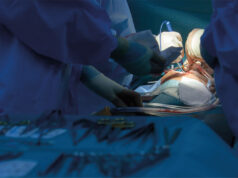
In the late 1970s, a neurosurgeon at New York’s St. Luke’s Hospital operated on a beautiful, young, rising soprano who studied opera at a major New York conservatory. She was delightful, full of the joy of living, and orphaned at an early age to raise her teenage brother. Having already overcome significant adversity, her only impediment to a blossoming career and a happy life was a brain tumor. The tumor appeared benign, and its resection was considered routine. The neurosurgeon was top notch, capable and clinically at the top of his game. There was not much that could go wrong.
But as happens in the arcane realm of neurosurgery, things went terribly wrong. After the skull was opened and the surgeon began to remove the tumor, the brain increased in size and poured out of the brain cavity. The surgeon was devastated. He and the anesthesiologist performed all of the maneuvers to shrink it back to size. It was of no use. More and more brain fungated from the skull. In a fit of absolute frustration, the surgeon gathered a fistful of brain tissue and disgustedly threw it against the wall. Despondent and defeated, the neurosurgeon turned to the resident assisting him and said: “She will not live. Close the skull as best you can.” Overwhelmed by a crushing sense of helplessness, he rushed hurriedly from the room.
It was my night to take care of patients and the neurosurgeon came to me. In a voice filled with anguish and despair, he bared his instruction. “Arthur, she may live a couple of days, but she will not survive. It would be best if you allowed her to die. There is no point in prolonging her suffering.”
An hour later, the patient arrived in the recovery room. Not culpable of any misdeed, her heart and lungs functioned perfectly. Her brain had betrayed her. I, in my innocence, could not let her die. I found I could not neglect her in her hour of need. I meticulously cared for her throughout the night with the concern of a shepherd guarding his injured lamb. I was too inexperienced and naive to do otherwise.
Persistence
For the next month, she became my charge. Her brother came in daily, cried, stayed for a while, and left. I performed every aspect of her care that required correction.
While her body stayed perfectly intact, she remained in a deep coma. Every morning I would jab a large needle into her left femoral vein and withdraw blood to be sampled. Every afternoon I would make whatever adjustments were necessary. My patient and I endured the ridicule of more sanguine colleagues who laughed—but did not interfere—with this ritual. I admit that without her active mental interaction, I began to think of her as a “thing” devoid of human qualities.
After more than a month, the neurosurgeon decided to try an operation, a ventricular-atrial shunt, to relieve the pressure in her brain. Since I was her de facto guardian, he allowed me—under his tutelage—to perform the entire operation. I drilled a hole into her skull, inserted a long needle into the right lateral ventricle, and was rewarded with the presence of clear, white fluid. The needle was connected to a thin plastic tube inserted into a vein in her neck. Perhaps futile, perhaps extravagant, the operation was at the very least, an attempt to remedy a catastrophe. Sometimes the human condition demands an act of expiation.
The next morning, to our utter surprise, the patient woke up. She actually sat up in bed, talked to us and ate solid food. Because of her youth, her recovery was rapid. Her sole disability was dyslexia. Everything she attempted to read was backwards. Given the immensity of the alternatives, dyslexia was a small price to pay and no great impediment; her memory was sharp.
Six months later, on a Sunday afternoon, I was invited to her recital at Juilliard. She gave a concert where she sang beautifully. She possessed a superb, operatic voice, with great control, range and command. Her brother, her only relative, was in attendance. To me, it was a triumph of perseverance over adversity. Medically, it was probably a miracle. At the reception following her concert, I summoned up the courage to ask her: “Did you feel any of those needles that I stuck into your groin?”
“Yes,” was her response, “and they hurt like hell.” Some 45 years later, and still mindful of this acknowledgment, I never dehumanize a patient.
The world of vascular surgery
Terri Schiavo was famously a patient in a vegetative state confined to a nursing home in Tampa 18 years ago. She was in a coma for 10 years. She was unable to meaningfully interact with her environment. We really don’t know what Terri Schiavo could perceive.
My patient was in a coma for only a month. Yet Terri’s condition demanded answers as to a timeless question: what is life? More profoundly: how do we respond to individuals who don’t conform to our definition of life? Do we have the right to terminate a life that we don’t find meaningful? Or are we simply imposing our biases on a defenseless human being? Our response says more about societal values than it does about a legislative or legal maelstrom.
This moral dilemma is even more conflicting today over the subject of abortion. There is little doubt that both sides are sincere in their belief, while the gulf remains irreproachable.
Part of my training took place at Harlem Hospital in New York. Back in the 1970s, Harlem was part of the Columbia Presbyterian system. As interns, we did a one-month rotation on the vascular ward. In those days, vascular surgery at a large city hospital was largely an amputation service. While revascularization was sometimes attempted, it was rarely successful, which led to a number of multilevel amputations.
The huge floor was comprised of large rooms, each of which housed eight African American patients. They were all poor, all alone, and all suffering withered limbs with varying levels of amputations. Wounds would be dressed daily. Healing was slow and their hospitalizations were long. These patients were uniformly cheerful and bore their lot in life with grace and good humor. After dinner, they would go out on a balcony to smoke, then return to their room to watch—and good naturedly argue over—the Yankees or Mets game on a beat-up television with rabbit ears. After retiring for the night, they would repeat the same sequence the following day.
One afternoon after making rounds and frustrated by any lack of progress of any of the patients, I made a statement to the group: “I would rather be dead than live like those patients.”
Our African American attending turned to me with a calm, unemotional voice and said: “Doctor, these patients may not be a White, young doctor from New Jersey with aspirations of becoming a great surgeon, but they have achieved something you don’t yet have. They enjoy a roof over their head, three meals a day, entertainment, and emotional support for each other. Their expectations may not be yours, but they have found contentment.”
In a slightly more forceful voice, he added: “You do not have the right to impose your values on them.”
Our medical landscape
Some people are slow learners. Some years ago, an elderly, very ill patient presented with a contained ruptured abdominal aortic aneurysm (AAA) and acute cholecystitis. It is an understatement to say he was sick and septic. In true Crawfordian fashion, I repaired the aneurysm, closed the retroperitoneum, covered it with omentum, then removed the bulging, necrotic gallbladder. I drained everything. He hung on for several weeks in the intensive care unit (ICU) experiencing multiple complications. He was returned to surgery several times, but the details have been forgotten.
Finally, one Saturday morning, he was again declining, some other problem having cropped up that could benefit from operative intervention. His overly supportive family was at his bedside.
As I explained the alternatives, his daughter with whom I enjoyed a very good relationship said:
“Whatever you think is best, doctor. We trust you.”
“We can try. Although he is very ill and may not survive,” I responded.
I walked towards the nurse’s station to book the case with the operating room. His hospital course replayed itself in my mind as I slowly acknowledged that he was not going to survive. I abruptly stopped. Retracing my steps, I re-entered the room.
The family looked at me expectantly. “I think I am operating for myself, not for your father’s benefit,” I explained. It is time to let him go. They cried and hugged me.
The story about the opera singer is true. The book is called Seizure. It was made into a television movie starring Leonard Nimoy.
As a doctor, I have fought death and illness for too many years to concede even one patient. Unfortunately, I’m not sure that my reverence for the profession is shared by private equity firms that increasingly dominate our medical landscape.
Perhaps I am still imposing my values on others.
Arthur E. Palamara is a vascular surgeon practicing in Hollywood, Florida, for 44 years. He is active in county, state and national medical organizations.












